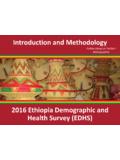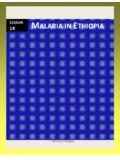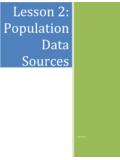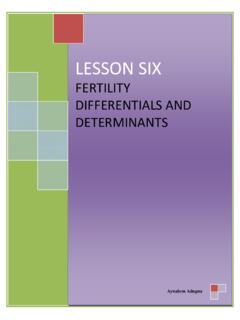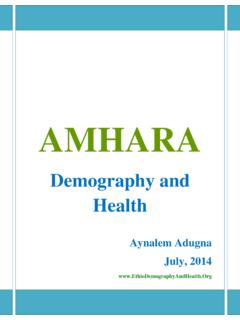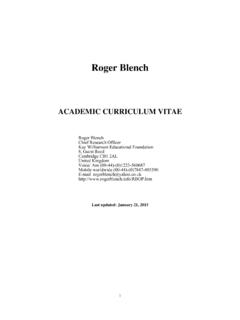Transcription of Chapter 2 Population Data Sources
1 34 Aynalem Lesson 2: Population Data Sources 35 Lesson 2 Population Data Sources Aynalem Adugna Learning Objectives: Introduction There are three Sources of Population data: Censuses Vital Registration Systems Sample Surveys I - Population Censuses Censuses taking started nearly 6000 years ago [1]. Babylonians are said to be the pioneers in the field, followed later on by Persians and other civilizations, including the Greeks, Romans and the various Chinese dynasties. The practice also underlies a fundamental belief in Christianity regarding Jesus Christ s place of birth. It was the five-yearly census ordered by Caesar Augustus which required every man in the Roman Empire to return to his place of origin, thus Census Explained The Advantages of Registration and Sampling The 2007 Ethiopian Census36 Lesson 2 Population Data Sources Aynalem Adugna ensuring that Joseph and Mary travelled to Bethlehem for the birth of Jesus [2].
2 The 1841 census of England and Wales is widely regarded as the first truly modern census. The following paragraphs are based on United Nations recommendations on census taking [3]: Census: Definition Population A Population census is the total process of collecting, compiling, evaluating, analysing and publishing or otherwise disseminating demographic, economic and social data pertaining, at a specified time, to all persons in a country or in a well delimited part of a country [3] Housing A housing census is the total process of collecting, compiling, evaluating, analysing and publishing or otherwise disseminating statistical data pertaining, at a specified time, to all living quarters1 and occupants thereof in a country or in a well-delimited part of a country [3]. A census must have the following essential features [3]: Individual enumeration each individual and living quarter has to be enumerated separately.
3 Universality A census must cover every individual or housing unit present within the defined census area. Simultaneity Each person and housing unit must be canvassed within a defined point in time. Defined periodicity - There should be a defined time gap between censuses. The most commonly used interval is 10 years. What are censuses useful for? To provide facts to policy makers and planners Policy development and management/evaluation of programs Gerrymandering or redistricting delimitation of election boundaries to insure adequate representation Scientific research Industry to determine consumer demand and availability of labor 37 Lesson 2 Population Data Sources Aynalem Adugna Other Censuses Agriculture Livestock Industry and commerce Two Types of enumeration: Canvasser (enumerator) method information on each individual or housing unit is entered by a census official.
4 Household method: responsibility for entering information given to an individual in the housing unit. List of Census Topics 1. Geographical and internal migration characteristics (a) Place of usual residence (b) Place where present at time of census, Locality (c) Place of birth (d) Duration of residence (e) Place of previous residence (f) Place of residence at a specified date in the past 2. Household and family characteristics (a) Relationship to head or other reference member of (b) Household and family composition household (c) Household and family status 3. Demographic and social characteristics (a) Sex (b) Age (c) Marital status (d) Citizenship (e) Religion (f) Language (g) National and/or ethnic group 38 Lesson 2 Population Data Sources Aynalem Adugna 4. Fertility and mortality (a) Children ever born (b) Children living (c) Date of birth of last child born alive (d) Deaths in the past 12 months (e) Maternal or paternal orphanhood Principles and recommendations for Population and housing censuses Topics collected directly Derived topics (f) Age, date or duration of first marriage (g) Age of mother at birth of first child born alive 5.
5 Educational characteristics (a) Literacy (b) School attendance (c) Educational attainment (d) Field of education and educational qualifications 6. Economic characteristics (a) Activity status (b) Time worked (c) Occupation (d) Industry (e) Status in employment (f) Income (g) Institutional sector of employment (h) Place of work 7. International migration characteristics (a) Country of birth (b) Citizenship (c) Year or period of arrival 8. Disability characteristics (a) Disability (b) Impairment and handicap (c) Causes of disability 39 Lesson 2 Population Data Sources Aynalem Adugna Source: [3] II. Vital Registration Systems Although local or parish registers were kept by some churches in Europe from the 14th century onwards, civil or state registration systems did not develop until the 19th and 20th censuses that describe the state of the Population at a fixed point in time, vital statistics are collected on a continuous basis [4] Life events registered under a complete registration system include [5]: Live Births Deaths Foetal deaths Marriages Annulments/ Legal separations Adoptions Important principles of a Vital Registration system: Universal coverage: A vital statistics system should include all vital events occurring in every geographic area and in every Population group comprising the national area.
6 Continuity: Continuity is important to insure that short-term fluctuations including seasonal movements, as well as long-term movements will be accounted for. Confidentiality: It is important to safeguard confidentiality of personal information and vital records to insure that use of information and data for specific administrative and statistical purposes is consistent with the intended uses of the records. Regular dissemination: The minimum requirements for using vital statistics should include a) the provision of monthly or quarterly summary, and b) the production of detailed annual tabulations of each type of vital event across classified by its demographic and socioeconomic characteristics. 40 Lesson 2 Population Data Sources Aynalem Adugna Definition of Vital Events [3] LIVE BIRTH is the complete expulsion or extraction from its mother of a product of conception, irrespective of the duration of pregnancy, which after such separation, breathes or shows any other evidence of life DEATH is the permanent disappearance of all evidence of life at any time after live birth has taken place (this definition excludes foetal deaths, which are defined separately below).
7 MARRIAGE is the act, ceremony or process by which the legal relationship of husband and wife is constituted . DIVORCE is a final legal dissolution of a marriage . ANNULMENT is the invalidation or voiding of a marriage by a competent authority , ADOPTION is the legal and voluntary taking and treating of the child of other parents as one's own, in so far as provided by the laws of each country. LEGITIMATION is the formal investing of a person with the status and rights of a person born in wedlock, according to the laws of each country. Summary Definition of Civil Registration Systems Civil registration is defined as the continuous, permanent, compulsory and universal recording of the occurrence and characteristics of vital events . These events pertain to the Population as decreed in accordance with the legal necessities of a country. It is carried out first and foremost for the purpose of putting in place the legal documents provided by the law.
8 Vital registration records are also a main source of vital statistical data. Data quality requirements for vital statistics include completeness of coverage, timeliness, and accuracy, of civil registrations. Locality According to a UN report a locality is defined as a distinct Population cluster (also designated as inhabited place, Population centre, settlement etc.), in which the inhabitants live in neighboring sets of living quarters and which has a name or a locally recognized status [3]. These entities should not be confused with the smallest administrative divisions of a country (a Kebele, in the case of Ethiopia). There might be an overlap between the two in some instances. But, in others, even the smallest civil division may contain two or more localities . [5] The recommended classification of localities by size-class is as follows: 41 Lesson 2 Population Data Sources Aynalem Adugna All localities 500,000 or more inhabitants 100,000 - 499,000 inhabitants 50,000 - 99,999 inhabitants 20,000 - 49,999 inhabitants 10,000 - 19,999 inhabitants 5,000 - 9,999 inhabitants 2,000 - 4,999 inhabitants 1,000 - 1,999 inhabitants 500 - 999 inhabitants 200 - 499 inhabitants Less than 200 inhabitants Population not in localities Vital registration in Ethiopia: a Brief History Tentative and largely symbolic efforts to establish a registration system in Ethiopia include the following: [6] The 1900 proclamation by Emperor Menelik to institute a registration system.
9 This was well-intentioned but failed to materialize. The 1960 Civil Code: This too remained unimplemented for lack of institutional support and enforcement. The city of Addis Ababa started birth registration in 1942. It started registering marriages and deaths in 1953 and 1970 respectively. However, this took place at the whim of individual residents with legal and other needs for a certificate. A 1980 proclamation stipulated that the Central Statistical Authority (CSA) will begin to undertake registration of vital events. All of the preliminary efforts and attempts to lay the groundwork for a national registration system proved costly and the plan was shelved in 1999. The proclamations of 1983/88 by the Derg to register births, deaths, marriages and Population numbers did not come to fruition. The 1995 FDRE constitution considered the naming of a child and record of his/her birth a fundamental right, but the law on civil registration has not come into effect.
10 [6]. Ongoing activities: Continuing efforts by CSA to develop the ground rules for a national program assisted by the UN and other donor agencies. 42 Lesson 2 Population Data Sources Aynalem Adugna CSAs continued efforts at model building, and testing. Continued canvassing by the tens of thousands of health care workers, who are supplying vital health information to a national database. The 2006 National Conference on registration of vital events entrusted the Ethiopian Human Rights Commission with the task of setting up a national- level task force. III Sample Surveys The following are obtained from a UN Studies in Methods series on Population sampling [26]. Household surveys provide a cheaper alternative to censuses for timely data and a more relevant and convenient alternative to administrative record systems.
